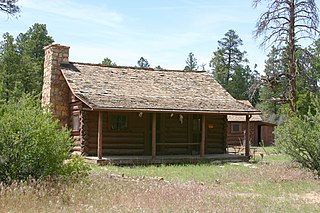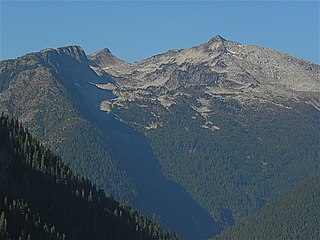
Lookout Studio, known also as The Lookout, is a stone building located on the South Rim of the Grand Canyon, within Grand Canyon National Park in Arizona. It is part of the Grand Canyon Village Historic District, and is part of the Mary Jane Colter Buildings National Historic Landmark. It currently operates as a gift shop and observation station for visitors, with telescopes on its outdoor terrace. Lookout Studio was constructed by the Santa Fe Railway in 1914 and was established as a photography studio to compete with Kolb Studio. It is one of six buildings at the Grand Canyon that were designed by architect Mary Colter, along with Bright Angel Lodge, Hermit's Rest, Hopi House, Phantom Ranch, and Desert View Watchtower. Lookout Studio employs her signature rustic style of using jagged native rocks to imitate indigenous structures of the region and to blend in with the environment.

The Watchman Lookout Station No. 168 is one of two fire lookout towers in Crater Lake National Park in southern Oregon. For many years, National Park Service personnel used the lookout to watch for wildfires during the summer months. It is also a common hiking destination because of its views of Crater Lake and the surrounding area. The building is unusual because it serves the dual purpose of fire lookout and museum. The Watchman Lookout Station is listed on the National Register of Historic Places.

The Apgar Fire Lookout in Glacier National Park is significant as one of a chain of fire lookout posts within the park. The low two-story frame-construction structure with a pyramidal roof was built in 1929. The design originated with the U.S. Forest Service and has been modified and re-used by the Forest Service and the National Park Service in a variety of contexts.
The Scalplock Mountain Fire Lookout in Glacier National Park is significant as one of a chain of staffed fire lookout posts within the park. The low two-story timber-construction structure with a pyramidal roof was built in 1931. The lookout affords views into the Park Creek valley and the Middle Fork of the Flathead River, which was traversed by the Great Northern Railway (U.S.) and US 2, prolific sources of fires. The lookout was built to standard plans derived from U.S. Forest Service plans.

The Loneman Fire Lookout in Glacier National Park is significant as one of a chain of staffed fire lookout posts within the park. The low two-story timber-construction structure with a pyramidal roof was built in 1933. The lookout uses a standard design originated by the U.S. Forest Service. Built in 1930, it is one several similar structures built in a program to establish an overlapping chain of fire lookouts in the park.

The Swiftcurrent Fire Lookout in Glacier National Park is significant as one of a chain of staffed fire lookout posts within the park. The low two-story timber-construction structure with a gabled roof was built in 1936. Its detailing is reminiscent of the Swiss Chalet style of the nearby Many Glacier Hotel. The design is modified from standard U.S. Forest Service plans. The Swiftcurrent lookout was listed on the National Register of Historic Places in 1986, and it is also listed on the National Historic Lookout Register.

The Mount Brown Fire Lookout in Glacier National Park is significant as one of a chain of staffed fire lookout posts within the park. The low two-story timber-construction structure with a pyramidal roof was built in 1928. The design was a standard U.S. Forest Service plan.

The Crane Flat Fire Lookout in Yosemite National Park was built in 1931. An example of the National Park Service Rustic style, the lookout is a two-story structure with a lower storage or garage level and an upper observation level, with an overhanging roof. Design work was carried out by the National Park Service Landscape Division.

The Shadow Mountain Lookout, also known as the Shadow Mountain Patrol Cabin, was built in Rocky Mountain National Park in 1932, to the design of the National Park Service San Francisco Landscape Architecture Division. It was regarded as one of the best National Park Service Rustic buildings in the national park system. It is now the only fire lookout surviving in Rocky Mountain National Park. Three other lookouts, now gone, were located at Twin Sisters Peak, the north fork of the Thompson River and near Long's Peak. The lookout was built by Civilian Conservation Corps labor.

The Twin Sisters Lookout, also known as the Twin Sisters Radio Tower and the Twin Sisters Shelter Cabin, was built by the U.S. Forest Service in 1914, the year before the establishment of Rocky Mountain National Park. The rustic stone structure was taken over by the National Park Service in 1925. The one-story building has an arched roof with a trap door to provide access when snow has drifted over the ground-level door. From 1914 to 1969 the shelter served as accommodations for fire observation crews at a nearby frame lookout, which has since vanished. The building is now used as a radio repeater station.

The Unity Ranger Station is a United States Forest Service compound consisting of five buildings and a lookout tower in the Wallowa-Whitman National Forest of northeastern Oregon. It was previously the administrative headquarters for the Unity Ranger District. It is located in the small unincorporated community of Unity, Oregon. The historic structures were built in the rustic style by the Civilian Conservation Corps between 1936 and 1938. Today, the ranger station is only used during the summer months to house Forest Service fire crews. The ranger station is listed on the National Register of Historic Places.

Suntop Lookout is located on Suntop Mountain in Mount Baker-Snoqualmie National Forest in central Washington, USA. The fire lookout is at an elevation of about 5,270 feet (1,610 m) overlooking the valleys of the White River and Huckleberry Creek just to the north of Mount Rainier National Park. Built to standard U.S. Forest Service plans, the one-story ground-level lookout measures fourteen by fourteen feet. The frame structure is capped by a pyramidal roof, and features large windows on all four sides with pivoting shutters that act as sunshades.

The Tolmie Peak Fire Lookout is one of four fire lookout stations built in Mount Rainier National Park by the United States National Park Service (NPS) between 1932 and 1934. The two-story structure houses a lookout station on the upper level and storage at ground level. The design was prepared under the supervision of Edwin A. Nickel of the NPS Branch of Plans and Designs. The newly completed structure lost its roof to a windstorm and had to be repaired. It is secured against strong winds by cables attached to deadmen. The wood-frame structure is used as a visitor contact point on weekends.

The Dodger Point Fire Lookout was built in 1933 in Olympic National Park as a fire observation station. The single-story frame structure is located on the peak of Dodger Point above the timber line at an elevation of 5,753 feet (1,754 m). Measuring 14 feet (4.3 m) by 14 feet (4.3 m), it is clad in wood clapboards and has a simple pitched roof covered with wood shakes. Large windows on all four sides are covered by awning-style wood shutters. It was built by the U.S. Forest Service in what was at the time Olympic National Forest, possibly with assistance from the Civilian Conservation Corps. During World War II, the lookout was used as an Aircraft Warning Service station. Dodger Point and Pyramid Peak Lookout are the only such stations remaining in Olympic National Park out of thirteen constructed.

The Pyramid Peak Aircraft Warning Service Lookout was built in the fall of 1942 in Olympic National Park to function as a spotter station guarding against intrusions by Japanese aircraft during World War II. The single-story frame structure is located on the southern side of Pyramid Peak. Funded by the U.S. Army, it was built by National Park Service employees Joe and Rena Shurnick as one of thirteen such sites within the present Olympic National Park. The 13-by-16-foot shed is clad in wood shingles and has a simple pitched roof covered with wood shakes. A small woodshed is located just to the north. There are unglazed window openings on each side of the shelter. The lookout was used as an Aircraft Warning Service station until June 1944, when the AWS was abandoned. Pyramid Peak and Dodger Point Fire Lookout are the only such stations remaining in Olympic National Park.

The Hull Cabin was built in the late 1880s near the South Rim of the Grand Canyon by settler William Hull. The Hull family arrived in the area in 1880 and established a ranch in the area, raising sheep and building the Hull Tank, a large earth-banked reservoir for their stock. The Hulls branched out into prospecting and were among the first to take in tourists heading to the Grand Canyon.

The Three Fingers Lookout is a historic fire observation building on one of the summits of Three Fingers Mountain in Mount Baker-Snoqualmie National Forest, Snohomish County, Washington. Built in 1930 in an extremely challenging location, it is one of the oldest surviving observation posts in the forest. It was listed on the National Register of Historic Places in 1987, and is now maintained by a local climbing group.

The Los Burros Ranger Station is a forest ranger station situated in Apache County, Arizona. The station was staffed by rangers who traveled to the nearby Lake Mountain Lookout.

Hidden Lake Peaks is series of peaks with a maximum elevation of 7,088 feet that are located in the North Cascades, in Skagit County of Washington state. The peaks extend three miles southwest from the nearest higher peak called The Triad. Situated on the western boundary of North Cascades National Park, Hidden Lake Peaks are positioned west of the crest of the Cascade Range, approximately ten miles east of the town of Marblemount. The popular subsidiary peak, Hidden Lake Lookout (6890 ft), lies a half mile to the southwest of the highest summit. The mountain's name is taken from its proximity to Hidden Lake which lies in a cirque below the east aspect of these two main peaks. Precipitation runoff from Hidden Lake Peaks drains into Cascade River which is a tributary of the Skagit River.

The Green Mountain Lookout is a historic fire lookout tower located at the summit of Green Mountain in the Glacier Peak Wilderness and the Mount Baker-Snoqualmie National Forest in Snohomish County, Washington. The single-story wood-frame structure measures 14 by 14 feet and was built according to a standard National Forest Service design in 1933 by the Civilian Conservation Corps. The structure includes an exterior catwalk and a cable anchor system to protect from strong winds.




















